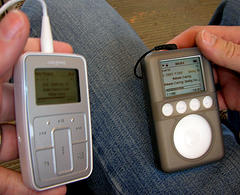
We would like to wish you happy holidays! We are looking forward to work with many of you next year!
Enjoy the snow 🙂
** Photo by velkr0

We would like to wish you happy holidays! We are looking forward to work with many of you next year!
Enjoy the snow 🙂
** Photo by velkr0

The new Pew Report on Future of Internet III was released a few days ago.
A survey of experts shows they expect major tech advances as the phone becomes a primary device for online access, voice-recognition improves, and the structure of the Internet itself improves. They disagree about whether this will lead to more social tolerance, more forgiving human relations, or better home lives.
http://pewinternet.org/pdfs/PIP_FutureInternet3.pdf
Major findings from the report:
• The mobile device will be the primary connection tool to the Internet for most people in the world in 2020.
• The transparency of people and organizations will increase, but that will not necessarily yield more personal integrity, social tolerance, or forgiveness.
• Voice recognition and touch user-interfaces with the Internet will be more prevalent and accepted by 2020.
• Those working to enforce intellectual property law and copyright protection will remain in a continuing “arms race,” with the “crackers” who will find ways to copy and share content without payment.
• The divisions between personal time and work time and between physical and virtual reality will be further erased for everyone who’s connected, and the results will be mixed in terms of social relations.
• “Next-generation” engineering of the network to improve the current Internet architecture is more likely than an effort to rebuild the architecture from scratch.
** Photo by Myxi
Interested in what’s going on at Google? There are a number of ways of doing this. Going to Google Labs will show you some of their cool new technologies.
What else is going on at Google? Searching the ACM Digital Library for Google in the Affiliations field retrieves 359 papers. The most recent being Programming the Intel 80-core network-on-a-chip terascale processor. A paper presented at the of the 2008 ACM/IEEE Conference on Supercomputing held in Austin, Texas.
Another good database to look at is Compendex. Repeating the same affiliation search in Compendex retrieves 278 papers. The most recent article in Compendex is A New Baseline for Image Annotation published in Springer Lecture Notes in Computer Science, volume 5304, pages 316-329, 2008.
Okay. Let’s look at how Google protects its intellectual property. A search of the Google Patents database for Google in the assignee name field retrieves 100 patents/patent applications with the most recent US patent 7,352,833 Method and System for Temporal Autocorrelation Filtering being published on May 8, 2008.
Repeating the same search in Espacenet retrieves over 1675 patents/patent applications with most recent patent/patent application US 20080301093 A1 Determining Search Query Statistical Data for an Advertising Campaign Based on User-Selected Criteria published on December 4, 2008.
Okay, here’s the challenge. Use Google Scholar find the most up-to-date recent articles, patents/patent applications written by researchers at Google. Let me know what you find and how easy it was.
Moral of the story. There is something to be said for databases such as Compendex, Web of Science and Scifinder Scholar that index thousands of journals and conference proceedings and have sophisticated search interfaces that allow you – the end user to find exactly what you are looking for.
Submitted by Kevin Lindstrom Kevin Lindstrom Liaison Librarian for Electrical and Computer Engineering, Earth and Ocean Sciences, Chemistry and Chemical Engineering, Materials Engineering, Physics and Astronomy, and Physical Geography.

An article in the New York Times looks on the pine beetle epidemic in North America – “Bark Beetles Kill Millions of Acres of Trees in West”
Many people in UBC deal with this precise issue. For instance, try a search on a very general multidisciplinary database such as Academic Search Complete here.
For more comprehensive coverage of this topic , try Web of Science or Agricola databases.
** Photo by Stephen Rees
Impact factors, Journal Citation Reports, the Science Citation Index and its online version the Web of Science are all statistical measures of the importance of journals and of the researchers who publish in them.
There are in fact journals that specialize in bibliometrics – the journal Scientometrics is one such example.
Dr. Jorge Hirsch, a physicist at UC San Diego has taken the “times cited” measure one step further by proposing the h-index “defined as the number of papers with citation number >h, as a useful index to characterize the scientific output of a researcher.”
Does the h index have predictive power? Hirsch, J. E. Department of Physics, University of California at San Diego, La Jolla, CA, USA. Proceedings of the National Academy of Sciences of the United States of America (2007), 104(49), 19193-19198.
Bibliometric measures of individual scientific achievement are of particular interest if they can be used to predict future achievement. Here we report results of an empirical study of the predictive power of the h index compared with other indicators. Our findings indicate that the h index is better than other indicators considered (total citation count, citations per paper, and total paper count) in predicting future scientific achievement. We discuss reasons for the superiority of the h index.
Using the Web of Science database, h-indexes can also be calculated for individual departments . For example, here’s the h-index numbers for a select number of Canadian university electrical engineering departments:
TORONTO 89
UBC 54
MCGILL 53
ALBERTA 51
The folks at Thomson Reutershave put together a short but very information video on impact factors and how to use the Web of Science database to find your own h-index.
Submitted by Kevin Lindstrom Liaison Librarian for the Physical and Appled Sciences, University of British Columbia

Here are four podcasts we recorded for the first annual Open Access day on October 14.
https://circle.ubc.ca/handle/2429/2689//browse-title
See all our Science and Engineering podcasts here
** Photo by andyi.
A new single gateway to NRC research is on the way. Following an NRC CISTI pilot project with seven NRC institutes, NRC has given the go-ahead to create an NRC Publications Archive (NPArC) that will provide access to NRC’s record of science and demonstrate the many ways NRC researchers translate science and technology into value for Canada.
This searchable, web-based repository will increase the access to NRC authored publications, guarantee long-term access to NRC’s research output, and serve as a valuable resource for NRC researchers, collaborators and the public. NRC-CISTI will manage and maintain NPArC.
As part of this initiative, NRC has established a policy making it mandatory, starting in January 2009, for NRC institutes to deposit copies of all peerreviewed, NRC-authored publications and technical reports in NPArC.
Wherever possible, NPArC will provide access to the full text of these publications. NRC’s Licence to Publish (Crown Copyright) will be updated to declare its intent to deposit the full-text of NRC-authored publications in NPArC. However, the nature, timing and extent of access to individual publications depends on a variety of factors, including agreements with publishers, or in the case of technical reports the sensitivity or confidentiality of content.
More information about the NRC Publications Archive will be available closer to the launch date in December 2008.
Source: CISTI News September 2008
Posted by Kevin Lindstrom Physical Sciences and Engineering Librarian

An article by Kevin and I has just been published early this week. It is free open access, please feel free to read and forward it to your colleagues:
Barsky E., & Lindstrom K. Podcasting the Sciences: A Practical Overview. Issues in Science and Technology Librarianship, Fall 2008.
Abstract:
University science education has been undergoing great amount of change since the commercialization of the Internet a decade ago. Mobile technologies in science education can encompass more than the proximal teaching and learning environment. Podcasting, for example, allows audio content from user-selected feeds to be automatically downloaded to one’s computer as it becomes available online, and then later transferred to a portable player for the user’s consumption at a convenient time and place. Enjoying a phenomenal growth in mainstream society, podcasting is asynchronous and could be provided at a distance from a classroom. This paper reports a case study from the University of British Columbia that implemented podcasting for physics content. It presents the rationale for, technical details, and step-by-step guide to creating podcasts in the sciences.
** Photo by Josh Bancroft

A major new global prize celebrating the work of both professional and amateur photographers has been awarded in Paris.
The Prix Pictet is the first competition of its type to focus on the global issue of ‘sustainability’ – and, this year in particular, on water.
The winner of 100,000 Swiss francs (£53,000) is the Canadian photographer Benoit Aquim.
Here is the BBC audioshow with the celebrated works – http://news.bbc.co.uk/2/hi/entertainment/7700551.stm
** Photo by visualpanic

Now after the election, it would be interesting to see whether Senator Obama will perform on the science and technology issues his campaign has promised.
Here is Obama’s platform on STM issues, accumulated by the American Association for the Advancement of Science – http://election2008.aaas.org/comparisons/obama.shtml
Do you notice something of a particular interest to you?
** Photo by jmtimages
UBC Library
Info:
604.822.6375
Renewals:
604.822.3115
604.822.2883
250.807.9107